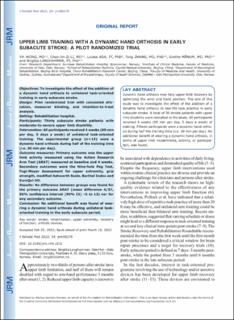Upper limb training with a dynamic hand orthosis in early subacute stroke: A pilot randomized trial
Peer reviewed, Journal article
Published version
Permanent lenke
https://hdl.handle.net/11250/3064174Utgivelsesdato
2022Metadata
Vis full innførselSamlinger
Originalversjon
Journal of Rehabilitation Medicine. 2022, 54:jrm00279 1-6. http://dx.doi.org/10.2340/jrm.v54.2231Sammendrag
Objectives: To investigate the effect of the addition of a dynamic hand orthosis to unilateral task-oriented training in early subacute stroke.
Design: Pilot randomized trial with concealed allo cation, measurer blinding, and intention-to-treat analysis.
Setting: Rehabilitation hospital.
Participants: Thirty subacute stroke patients with moderate-to-severe upper limb disability.
Intervention: All participants received 4 weeks (60 min per day, 5 days a week) of unilateral task-oriented training. The experimental group (n=15) wore a dynamic hand orthosis during half of the training time (i.e. 30 min per day).
Outcome measures: Primary outcome was the upper limb activity measured using the Action Research Arm Test (ARAT) measured at baseline and 4 weeks. Secondary outcomes were the Nine-hole Peg Test, Fugl-Meyer Assessment for upper extremity, grip strength, modified Ashworth Scale, Barthel Index and EuroQol-5D.
Results: No difference between groups was found for the primary outcome ARAT (mean difference 4/57, 95% confidence interval (95% CI) –5 to 13) nor for any secondary outcome.
Conclusion: No additional benefit was found of wearing a dynamic hand orthosis during unilateral task-oriented training in the early subacute period.

